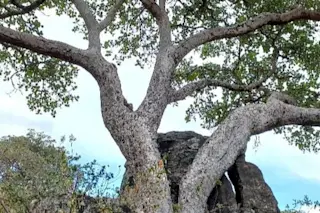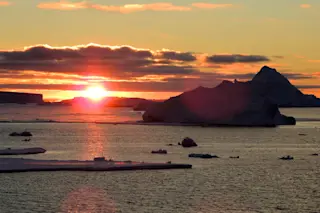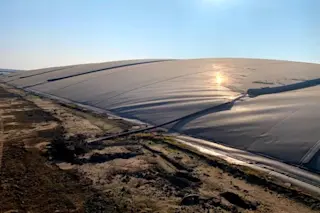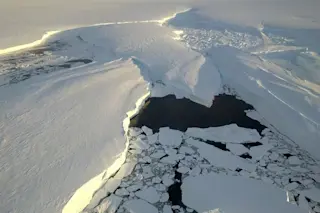In the rocky Barren Lands of Canada's Northwest Territories, where you can go a thousand miles without seeing a road or tree, Charles Fipke was standing a few months back in ankle-deep mud at the face of a mine 700 feet below the bed of a small lake. With a hammer, he cracked out a fist-size chunk of gray rock, shoved it into the beam of his helmet lamp, and eyeballed it with an intense scowl. Then he dropped it into his battered brown backpack and turned to go. Once again he was digging ore from the belly of his own personal beast--the innards of an ancient diamond-bearing volcano.
Rich diamond veins, called pipes, are so difficult to find that only 15 major ones are known, and they're all in Africa, Siberia, and Australia. Until now, not one major pipe has been discovered in the Western Hemisphere. Yet Fipke and friends have unearthed what may be a whole cluster. To find them, Fipke--armed chiefly with a B.S. in geology, an uproarious laugh, and an absentmindedness manifested in perpetually untied shoelaces--had to track clues through the wilderness for a decade and outsmart the pursuing South African De Beers cartel. Now he is sitting on deposits probably worth billions, and Canada may soon be a world-class diamond producer. In a boulder-strewn sub-Arctic landscape where wolves and caribou roam, 260 companies have staked out 53 million acres; drill rigs brought in by helicopter have settled on the tundra like mosquitoes to suck out core samples; ore trucks rumble from blasted-out tunnels; and whole villages of geologists have sprung up. What they are finding opens a brand- new window on the supersecret world of diamond exploration. It could change the diamond market--and the wild, isolated Barren Lands--forever.
Fipke, now 48, once wanted to be an ornithologist. But as a student in the late sixties at the University of British Columbia, he studied geology because he had a young family to support ("With geology you can at least get a job, eh?"). For seven years he, his wife, Marlene, and their kids bounced through mining outfits in Brazil, New Guinea, Australia, and South Africa. Then, back in the small British Columbia city of Kelowna, they spent half their $12,000 savings to open a business processing mineral samples for prospectors. Fipke sorted dirt in homemade backyard machines; Marlene dried piles of gravel in the kitchen gas oven.
In 1978, Hugo Dummett, a South African geologist working for Superior Oil, hired Fipke to look for base metals, gold, and diamonds-- Fipke's first stab at this commodity. They headed for the Colorado Rockies, where previous explorers had found a few, albeit small, diamonds. Colleagues remember Fipke's eccentric enthusiasm: "On a steep slope at 10,000 feet, Chuck would jump out of a helicopter like he was getting off a bus," says Tom McCandless, a fellow geologist. "He'd collect rocks in a golf shirt and a vest from Kmart while everyone else had a down parka." Dummett--who himself cuts a figure somewhere between a U.S. senator and a bear--went roped with Fipke to keep from falling into snow crevasses. They worked their way up into the Canadian Rockies, finding occasional clues but few diamonds.
Since knowledge of how diamonds form and where they appear was-- and still is--theoretical in many respects, companies like Superior guard their scientific information closely. The stakes are high: a diamond mine can be worth $6 billion or more. For decades industry scientists have tried to target sites by analyzing every physical, geologic, and chemical aspect of known mines, and by re-creating diamonds and other minerals in the lab. Company scientists are organized into guerrilla-like cells, so no one knows too much about what others do. Thus, at Superior, Fipke was instructed to tell no one what he was looking for, or where. Nor could Dummett, in charge of day-to-day exploration, tell Fipke about any of the company's efforts to develop new diamond-finding technologies.
In the last several years, some of what was then secret about diamond mining has emerged. It is thought that most diamonds come from at least 70 miles down, within Earth's mantle. There, under enormous pressure and at temperatures of 1700 to nearly 2300 degrees Fahrenheit, carbon atoms form crystals. (A recent find of Brazilian diamonds from more than 400 miles down suggests there may be no depth limit.) In many areas, though, the geothermal gradient is too high: that is, as depth increases, temperature goes up too steeply because of friction from moving rock. The right combination of great pressure and low temperature--the "diamond stability field"--seems to occur chiefly under archons, the most ancient nuclei of continents, to which more recent landmasses are appended. Apparently archons, stable for at least 2.5 billion years, develop solid, cool "roots" with the proper gradient. Studies in the 1960s duly located archons under the African and Siberian diamond fields. But by 1990 seismologists had mapped an archon containing the world's oldest dated rock--3.962 billion years--in a place where diamonds were unknown: the Barren Lands of Canada.
Dummett had hired Fipke to look for kimberlite pipes, which are the volcanic routes through which diamonds rise. Kimberlite begins as magma in Earth's mantle. For reasons that are unclear, the kimberlite erupts from farther down than ordinary volcanic rock, which comes from roughly 6 to 50 miles down. No one knows what triggers kimberlite pipes, nor why they come in clusters of 6 to 40. One theory says disturbances in Earth's magnetic field periodically send them through weaknesses in the bedrock. The oldest known kimberlites are 1.6 billion years old; the youngest, in Tanzania, date back 40 million years.
Kimberlites are like elevators picking up passengers: as the magma smashes through layers of rock, it rips out debris, creating a supercharged breakfast cereal of liquid and solid material; if it intersects diamonds, some may come along. If they are to survive, though, they must shoot to the surface quickly; estimates vary from hours to weeks. Otherwise they revert to graphite or they burn--probably the fate of many. Near the top, liberated from the pressure of surrounding rock, the pipe blows out a carrot-shaped crater that can cover many acres, then settles back in to cool off. Layers of unrelated rock may subsequently build up over the pipe. In the Canadian Northwest, where Fipke roams, most pipes are under small lakes: kimberlite is softer than bedrock, and when glaciers come through, they scoop out depressions over the pipes, which later fill with water. At some point a few hundred million years later, humans dreaming of clear, tiny stones may come looking for such a spot.
Diamonds are so rare that they are almost impossible to detect directly: very rich pipes contain maybe three carats per ton of kimberlite. So explorers look for specks of "indicator minerals" peculiar to the mantle but carried up in far greater quantities than diamonds and eroded out of pipes into the surrounding land. The standard ones are reddish pyrope garnets, dull-hued chromites, iron-heavy ilmenites, and bright green chrome diopsides. The problem is that one can spend years panning indicators out of streambeds, beaches, even anthills, and trace them back to their source, but 90 percent of the 4,000 kimberlite pipes found this way are barren, and most of the rest are too sparse to mine.
"You can spend your life looking and never see a diamond," says Chris Jennings, a geologist who worked for one of Superior's partners when Fipke was hired. And Jennings knew: he had combed Botswana's Kalahari Desert for kimberlite pipes and found dozens, but none good enough for a mine. He badly wanted a secret weapon, a new way to locate a diamond-rich pipe.
He believed he'd found it in 1978 when he hired a Cape Town geochemistry professor named John Gurney as a consultant. Gurney had analyzed samples of indicator minerals from all over the world. Many came from mines held by De Beers, which directly or indirectly controls 80 percent of the world diamond market.
What Gurney discovered was simple but significant: the garnets, chromites, and other indicator minerals found in diamond-rich pipes--and in diamonds themselves--had subtly different chemical signatures from those found in barren ones. He zeroed in, for example, on G10 garnet, which is lower in calcium (under 4 percent) and higher in chrome than other garnets. "Diamond inclusion" chromite, too, was high in chrome--62.5 percent or more. He showed that the minerals took on these compositions only in the diamond-stability field; more common versions came from elsewhere in the mantle. Gurney also found that though ilmenites did not form in the diamond-stability field, there was a link useful for prospectors: when the iron in ilmenite was highly oxidized, a pipe contained few diamonds. He reasoned that the iron took on more or less oxygen in response to conditions in the kimberlitic magma itself--mainly in response to heat and the available oxygen. When iron got highly oxidized, so did diamonds; that is, they vaporized into carbon dioxide. If garnets and chromites gauged how many diamonds entered the kimberlite, then ilmenites measured how many survived. Dummett and Jennings were delighted; they could perhaps save years of effort and beat competitors to a mine by knowing which mineral trails were worth following.
Fipke, of course, possessed only what was then general knowledge- -that indicators could lead to kimberlite but not necessarily to diamonds. Dummett and Jennings pointedly never told him about Gurney's formulas. By July 1981, Fipke and his small crew were taking mineral samples in the Northwest Territories' Mackenzie Mountains, about 1,200 miles north of the U.S. border. When Dummett heard from a local bush pilot that he'd been flying supplies to a De Beers crew at a wilderness site some 100 miles away, everybody's ears pricked up; the cartel had unsuccessfully scoured Canada for 30 years, from the high Arctic to the U.S. border. What were they doing nearby?
Fipke flew out on a spy mission and located the camp. "A guy came out of a tent and looked up at me with binoculars," Fipke remembers. Later, with Stewart Blusson, a geologist and participant in the venture, he sneaked near the De Beers claim at 2 A.M. while the De Beers geologists snoozed. Fipke and Blusson filled half a dozen sample bags with dirt and escaped unseen. John Gurney analyzed the samples and reported back to Dummett. He had found garnets, chromites, and ilmenites with perfect compositions for diamonds. Dummett phoned Fipke--after having the phone checked for bugs--to discuss the find. "Hugo was ecstatic," Fipke recalls. "He told me the compositions of the minerals indicated diamonds, but he wouldn't tell me why."
Shortly afterward, however, Superior unexpectedly stopped the hunting expedition. At the time, the company was in negotiations with De Beers on another project and didn't want to jeopardize it by competing with the cartel in Canada. Fipke and Blusson were convinced they had something. They pulled together a couple of small investors, put in their own money, and went ahead on their own.
Blusson, a wiry, weathered man seven years Fipke's senior, had worked in the Yukon and Northwest Territories for 20 years and had grizzly- bear claw marks on his left arm to prove it. He also knew how to fly a helicopter, a necessity in a land with no roads. Blusson thought De Beers was "out to lunch" wasting time looking for the source of the indicators here. He knew that glaciers had swept into this very area from hundreds of miles to the east, out of what was now the Barren Lands. The last glacier, towering at least a mile high, had melted just 10,000 years ago, leaving an endless landscape of pulverized debris. Anything this powerful had to be taken into account: the glaciers, he figured, had passed over some pipes, scraped off their tops, and kept on going, taking the minerals with them. When the ice melted, the indicators would have dropped out and washed westward with meltwater. The kimberlite pipes had to be out there somewhere. "I knew we had to follow the ice back, like tracking an animal," says Blusson.
Fipke and Blusson didn't know precisely what they were looking for--the exact compositions of the best indicator minerals were still known only to Gurney, Jennings, and Dummett. But they knew enough. For much of 1982 they dug mineral samples up-ice, trying to trace the mineral train back. Streambeds, lake beaches, and eskers--giant miles-long ridges of sand and gravel left by rivers that had flowed through melting ice--often proved fruitful. By winter they had worked their way 150 miles east, and they continued to find minerals with compositions that strongly hinted at diamonds.
Still, the amount of money they were spending was scary: a small helicopter costs $600 an hour to run; a mineral analysis costs up to $1,000. They could not live like the De Beers folks, for example, who had ice for their scotch flown in by helicopter during warm weather and went home before things froze over at the end of the eight-week summer. Not wanting De Beers to know they were following the glaciers, the pair tramped around in snowshoes in the fall. Blusson flew solo, filing no flight plan and keeping radio silence. One day he landed in cold so intense he couldn't restart the engine. Realizing no one knew his position, and afraid of freezing, he gathered some stunted birches and built a fire under the engine until it warmed enough to turn over.
When winter grew too cold even for the two geologists, Fipke holed up in his lab, which now occupied several unmarked bays in a one- story cinder-block building off Kelowna's commercial strip. Today it is still there, sandwiched between Barnes Storage Equipment Supplies and Top Notch Auto Upholstery, and located down the road from a decaying amusement park called Original Flintstones Bedrock City. Most days he worked there from 9 A.M. to 2 A.M. Sometimes he could separate out only three or four specks of indicator minerals from a 20-pound sample, but it was enough to keep them going.
By 1985 they were out of money, and Fipke founded Dia Met Minerals, floating shares as low as 17 cents each to neighbors and friends in Kelowna. Secretaries at the lab bought some; so did neighbors, family friends, and the owner of a Greek restaurant where Fipke ate late at night. That summer he flew with 17 different bush pilots, picking up samples in an arc ranging nearly 800 miles east of his and Blusson's starting point. In Fipke's lab that winter, something jumped out: about 350 miles out, near a place he named Little Exeter Lake, the indicators got bigger and more numerous; one esker sample had an astonishing 6,000 pyrope garnets. Yet just a little farther on, the minerals dropped off--meaning he'd probably reached the pipe field. Now all he had to do was find the pipes--no mean feat in a land where everything can be covered with 100 feet of glacial till.
Around this time Gurney's research leaked. The Russians, it turned out, had been working along the same lines he had, and they began publishing papers. Gurney wanted credit, so he published, too. Fipke wrangled a grant from the Geological Survey of Canada to build a data base and imported one of Gurney's top students to help. "Then I learned everything," says Fipke. "I finally knew what I was doing." He reanalyzed his earlier samples and found that the indicators around Little Exeter Lake reeked of diamonds.
By the summer of 1988, Fipke had set up a tent camp near the lake, bringing his son Mark, then 22, and bush pilot and venture capitalist David MacKenzie. (Blusson by this time was conducting his own explorations.) The closest town, 200 miles southeast, was tiny Yellowknife, situated near the dead end of a gravel road. Little Exeter Lake is in an area of rolling, heath-covered ridges, vast fields of giant boulders, and towering, sandy eskers that run to the horizon. Thousands of bright blue lakes--mostly unnamed--lie everywhere. Here, in the intense round-the-clock summer light, they worked 18 hours a day shoveling dirt and lugging it around in backpacks. Tracing the source of the indicators was mind- boggling: indicators were everywhere, and the glaciers here appeared to have lumbered around in three or four directions.
Fipke became a terrorizing taskmaster. "I knew we were getting close," he says. "I was hungry." At one point MacKenzie, sent to land on an esker to collect what Fipke considered a vital sample, touched down too hard and flipped his plane upside down. When the bruised pilot stumbled into camp after walking 25 miles, Fipke ran up to him. "Where's the sample? Where's the damn sample?" he shouted. MacKenzie just stared at him. One helper was driven mad by the Barren Lands mosquitoes, which attack man and beast in thunderclouds during the summer. He tore off his bug suit--a sealed mesh jacket and face hood that is de rigueur--as well as his shirt, and screamed for the bugs to come get him. They did, and he went home on the next plane.
Soon Fipke was in a quandary: to obtain exclusive rights to explore land, you must claim it by marking it out with wooden stakes and registering it with the government. However, he was unsure where to stake to make certain he got the pipes; and he knew once he did stake, competitors might rush in like homesteaders and cut him off at the pass he himself had led them to. In the summer of 1989 he started quietly, trying to lay out as much acreage as possible, telling anyone who asked that they were prospecting for gold. They worked until October, when the winds grow icy and lakes can freeze a foot thick in three days. Afraid he hadn't covered enough, Fipke insisted on returning in April, when it was still winter. By the twelfth of the month, their hired helicopter had eaten their budget, and they could stay only one more day. That evening Fipke looked down from the aircraft at a small frozen lake at the very edge of the claim. He'd never noticed it before, but its strangely plunging depth and circular shape reminded him of kimberlite pipes he'd seen in South Africa. That night he couldn't sleep. "I just kept thinking of this lake," he says. In the morning he headed back to it.
In search of a sample at the shoreline, Fipke, Mark, and MacKenzie dug through six feet of snow until they hit a jumble of boulders. They chipped through two feet of ice to reach ground but hit only more big rocks. Another excavation got the same results. And another. Five hours later, recalls MacKenzie, he could still see Fipke in a hole over his head, clawing away at the frozen earth. Facing frostbite and exhaustion, they moved to some glacial till down-ice from the lake and found a patch of ground the powerful winds had swept bare. Their hammers just bounced off. Then Mark bent over and picked up a bright green, pea-size chunk. It was chrome diopside--a rare kimberlitic mineral so soft it usually disintegrates completely a mile or two from a pipe. A piece this big meant they were right on top of something. They named the place Point Lake and raced home.
They were right to hurry. De Beers was rumored to be lurking in the Barrens. And Chris Jennings, aware of the original indicators that led Fipke here, had come to Canada himself to stalk the mineral train secretly. After various starts and stops, he was also nearby. When he heard Fipke was staking, he unsuccessfully pleaded with his employers to grab a promising parcel from under Fipke. Fipke and his partners, verging on bankruptcy and fearing claim jumpers, went to Hugo Dummett, now an executive for Broken Hill Proprietary, an Australian mining conglomerate with worldwide interests. Dummett quickly saw what Fipke had, and BHP agreed to front a half-billion dollars in exploration costs in return for a 51 percent controlling interest in the claim.
BHP wasted no time bringing in big-gun exploration technology. They had expensive aircraft tow magnetometers and electromagnetic transmitters and receivers over the area: company scientists knew that minerals in kimberlite pipes sometimes give off magnetic fields that distinguish them from surrounding bedrock. They may also conduct electricity better; by inducing electromagnetic fields over the ground and measuring the waves that return, geophysical instruments can plot areas of high conductivity. "Point Lake just lit up," says Dummett. He ordered a drill rig slung in by helicopter and angled it under the lake bed from the shore. Drilling down 455 feet, an unusual gray rock started coming up in the core: kimberlite. Because Canadian law requires that public companies announce significant finds, on November 12, 1991, BHP sent out an eight- sentence press release: the core contained "81 small diamonds," some of "gem quality."
The reaction was instant. De Beers raced in to stake land--any land--nearby. Within days Chris Jennings and Grenville Thomas, a Welsh former coal miner who ran a small Arctic exploration company, were pounding stakes in the snow. When they ran out of money, three other hastily organized outfits surrounded their claim--and so it went. To save time, helicopter crews, guided by Global Positioning System readouts, just threw the stakes out the door; workers came along later and drove them in. Sometimes opposing teams ran into each other on the tundra and were forced to make boundary agreements on the spot. BHP and Dia Met managed to expand their ground to 960,000 acres before the competition hemmed them in.
Competing scientists began to do some high-tech claim jumping. Since many had only a general knowledge of how to detect kimberlite pipes with geophysics, the airspace over Point Lake suddenly swarmed with planes trying to calibrate their instruments on the pipe's signature. BHP retaliated by looping an electric cable around the lake; when enemy aircraft swooped in, they switched on a generator, sending out a field that made airborne instruments go crazy. BHP and most of the others fielded small air forces armed with instruments to root out every magnetic or conductivity anomaly in their new domains. Soon they identified dozens of possible targets resembling Point Lake and slung in drills. To prevent the opposition from seeing, crews hung camouflage nets over their rigs.
The results of this barrage of exploration--companies have spent some $250 million so far--have been spectacular. At least 100 kimberlite pipes have come to light, a third "diamondiferous"; some estimate there may be 1,000 pipes out there. BHP alone has 26; its highest-grade one is the misnamed Misery, with an extraordinary 3.3 carats per ton, according to preliminary tests. Diamonds in nearby Panda Pipe are less numerous but of far greater quality--valued at $127 per carat, which compares well with major African and Siberian mines. De Beers is something of a laughingstock to the Canadians; it still hasn't found any good pipes, but it recently entered into a joint venture to develop the Torrie Pipe, named after the geologist who found it. Jennings's group has found at least two promising pipes. BHP, the first company with mining plans, has targeted four pipes for production by 1997, pending environmental permits, and has tunneled out 5,000-ton ore samples to confirm the pipes' diamond content.
You know BHP is confident of the pipes' value when you fly from Yellowknife to see what the company is doing in the diamond fields. For an hour or more you pass over an uninhabited landscape of rock-speckled green and brown tundra pocked with a million lakes stretching to the horizon. Finally, perhaps 50 miles away, something alien and white shimmers. Closer, it looks like a settlement on the surface of Venus: it is the BHP ore- processing plant, a tentlike structure covering many acres, with arched portals, side structures multiplying in every direction, and vents jutting through the roof like minarets--a sort of Taj Mahal of the tundra. Like much of BHP's scientific talent, it was imported from South Africa, world center of diamond expertise, airlifted by giant Chinook helicopters, and reassembled on the spot. A complex of satellite developments connected by brand-new roads sprawls for miles: tanks for 1.2 million gallons of diesel fuel, heavy-equipment sheds, dorms for 200 workers, and a mile-long airstrip for the world's biggest cargo jets.
Not far away is one of the tunnels that feed the plant. A yawning ten-foot-wide black hole angles through the ground toward Fox Pipe, which is under a nearby lake bed. Two giant ventilation tubes protrude, as if from the maw of an insect. One day Fipke and a couple of visitors pile onto a tractor, and the driver heads down into the darkness. After a bone- jarring half-mile ride, they reach the face of the shaft, which has just hit the pipe itself. Water seeps from the walls; three miners in raincoats pause before placing explosives to blast out another load.
Fipke is now just a visitor here: it seems BHP, with its controlling interest and hordes of employees, has swallowed him as surely as the mine itself has. He spends much of his time in Kelowna, and many workers at the site don't know who he is. The diminutive geologist spends a few minutes hammering off some samples and turns to go. "Are you a reporter?" one of the miners asks him. "Uh . . . no, no, I'm just with Dia Met," he stutters. Back in the daylight, huge, low-slung trucks haul the ore to the processing plant, where it runs through a series of crushing wheels, screens, and sprayers and is separated into heavy minerals and, it's hoped, a few diamonds by a centrifuge. At the end of the line, inside a padlocked cage, a vertical steel pipe shoots a stream of black gravel-- the diamond concentrate--into a small bucket. When Fipke asks to see some of it up close, the hard-hatted BHP security guard will not allow him to touch it; he peers at it curiously like everyone else, looking for invisible diamonds in the sludge. The concentrate is flown in locked 55- gallon drums to Reno, Nevada, where a machine picks out stones to be sent to appraisers in Antwerp, Belgium, who will assess color, clarity, size, and shape.
Fipke is being lionized as the man whose work may finally lead to the first lucrative diamond pipe in the Western Hemisphere. "He's a hero," says Don Brown, a senior adviser on mineral resources for the Canadian government. "He went up against fantastic odds. He put luck, faith, and science all together. You could live a hundred lifetimes and not find what he found." But is this a heroic endeavor?
"They're going to rape one of the last wild places on Earth for engagement rings," says Chris O'Brien, a director of Ecology North, a group concerned about the exploration. The diamond fields lie in the migration route of the 325,000-strong Bathurst caribou herd, one of the largest free- roaming groups of mammals on earth. Just outside the BHP camps you can see groups of them galloping over the hills, their velvety antlers so big they seem like giant puppets. Wolves trot along, ignoring human intruders. Such peaceful coexistence may not last: an estimated 8 to 10 percent of the region's grizzlies, for example, were shot last year by the booming human population--a death rate that's probably unsupportable. BHP plans to drain the lakes that cover its four targeted pipes for quarter-mile-deep open-pit mines. For 24 hours a day, 365 days a year, giant machines will shatter the Arctic stillness, sifting through about 65 million tons of rock a year. Since no one knows how many pipes lie undiscovered, this may be only the start.
More than these mines--even on this scale, arguably specks on the vast map--may follow. Industry leaders have talked for years of opening the Barrens with a road to truck out its potentially rich but inaccessible zinc, silver, and gold deposits. Diamonds may push this into reality, encouraging ever more development and allowing hunters to drive in. In July the World Wildlife Fund asked the government to put BHP's environmental permits on hold until it can assess the "cumulative effects" of all the companies' explorations. But the Northwest Territories badly needs jobs, and the government seems to be behind the miners.
As for Chuck Fipke, he appears to be untouched by what he has unloosed; since BHP took over, he doesn't seem to have that much to do anymore. He's worth maybe $350 million but drives around in the same battered black '85 Ram Charger. He showed up at a recent Dia Met meeting in unlaced sneakers and ripped pin-striped pants. His voice tightens at the suggestion that mines could harm the Barren Lands; he insists he couldn't have done this without a love of wild places. Indeed, his innocent enthusiasm outdoors still shines: on a recent visit to Point Lake, he crawls around on his hands and knees looking for garnets in the dirt. "Oh, look! Here's a beautiful one!" he exclaims, turning it over and over in the sun and finally handing it to a friend as a gift. Upon leaving, he forgets his geologist's hammer on a rock.
One day at BHP he meets Len Demelt, manager of one shaft where the company continues to drag kimberlite out of the earth to feed the ore processors. In a badly lit bunker at the mouth of the














